Wholesale Attack on Due Process
•
Stop Criminalizing and Deporting Migrant Children
• Judges’ Union Calls for Separating Immigration Courts from the Justice Department
• Federal Government Planning Massive Family Detention Center in South Texas
• Nine in Ten Children With No Lawyer Deported • Children in Danger: A Guide to the Humanitarian Challenge at the Border
Wholesale Attack on Due Process
Stop Criminalizing and Deporting Migrant Children
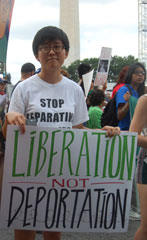 President Obama announced in July that absent action by Congress, he planned to take executive action on immigration by the end of summer. Those fighting for immigrant rights have demanded that he stop the massive deportations that have ripped millions of families apart — Two Million Too Many they declare — and provide Legalization for All Now! Instead, the White House recently announced, again, that it is not yet ready to take action on these issues. Many across the country responded with great anger and denunciation of Obama's refusal to Stop the Deportations Now! The deportations and raids to accomplish them have served to terrorize communities, separate families and create great insecurity. Obama has power to stop the deportations, just as he has used that power to impose them.
President Obama announced in July that absent action by Congress, he planned to take executive action on immigration by the end of summer. Those fighting for immigrant rights have demanded that he stop the massive deportations that have ripped millions of families apart — Two Million Too Many they declare — and provide Legalization for All Now! Instead, the White House recently announced, again, that it is not yet ready to take action on these issues. Many across the country responded with great anger and denunciation of Obama's refusal to Stop the Deportations Now! The deportations and raids to accomplish them have served to terrorize communities, separate families and create great insecurity. Obama has power to stop the deportations, just as he has used that power to impose them.
At the same time, in July, Obama did act against the rights of migrant children, demanding that the thousands of children be fast-tracked through the immigration courts and deported.
The large majority of the children are refugees, fearing for their lives and attempting to escape violence and persecution imposed on their countries by the U.S. “war on drugs,” and its backing of reactionary governments, such as that installed by the U.S. in Honduras. Rather than treating the children as refugees and having them dealt with by the Department of Health and Human Services (HHS) — one of the only departments still without a major police force — Obama is having Immigration and Customs Enforcement (ICE), one of the largest policing agencies, and the Border Patrol deal with the children. HHS, unlike ICE, has social workers, churches and other non-police forces interview and care for the children. ICE and Border Patrol have armed agents detain and interview them, often with no interpreters. The government stand is one of criminalizing the children and “welcoming” them into the militarized U.S. culture that now pervades the border and its policing agencies.
Contrary to U.S. and international law, the children are being detained in military and other prison-style detention camps. International law says that children “should in principle not be detained at all,” according to the United Nations High Commissioner for Refugees (UNHCR). Detention, if used, should only be a “measure of last resort” for the “shortest appropriate period of time,” with an overall “ethic of care.” U.S. law also calls for detention to be a “last resort.” Instead it is the first action taken.
An indication that this government crime will continue is the fact that Immigration and Customs Enforcement (ICE) is currently negotiating with private prison monopoly Corrections Corporation of America (CCA) to open a large family detention center in Texas. CCA is notorious for securing profits while imposing horrendous conditions for prisoners and immigrants. As a result of mass protests and court actions, in 2009 CCA was forced to shut down the T. Don Hutto family detention center it formerly operated, also in Texas. Even so, the government is again unjustly detaining children and families and making this injustice a source of guaranteed profits for the CCA private monopoly.
Wholesale Attack on Due Process Rights
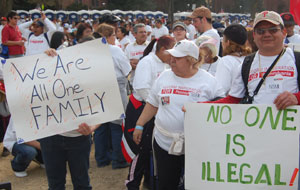 Directives from Obama have also meant a wholesale attack on due process in the immigration court hearings. The children are being fast-tracked, with cases that normally take months and years to prepare being done in weeks. Many have no legal representation of any kind, with 9-in-10 without lawyers being deported. The government is demanding children come before the judges within 21 days and the judges are being disciplined if they do not swiftly hear and decide the cases. Lawyers report that they are being blocked from seeing their clients in advance — children and mothers — and in some cases not permitted to speak in court. Children, many who do not speak English are being required to fill out forms in English, present evidence and make their case to the judges. The judges are being forced to hear many more cases and are already contending with a massive backlog. These attacks are such that immigration judges are denouncing the executive actions (see article below) and demanding that the immigration courts be removed from the executive branch. As one stated, “A truly independent court needs separation from the executive branch’s enforcement prerogatives.”
Directives from Obama have also meant a wholesale attack on due process in the immigration court hearings. The children are being fast-tracked, with cases that normally take months and years to prepare being done in weeks. Many have no legal representation of any kind, with 9-in-10 without lawyers being deported. The government is demanding children come before the judges within 21 days and the judges are being disciplined if they do not swiftly hear and decide the cases. Lawyers report that they are being blocked from seeing their clients in advance — children and mothers — and in some cases not permitted to speak in court. Children, many who do not speak English are being required to fill out forms in English, present evidence and make their case to the judges. The judges are being forced to hear many more cases and are already contending with a massive backlog. These attacks are such that immigration judges are denouncing the executive actions (see article below) and demanding that the immigration courts be removed from the executive branch. As one stated, “A truly independent court needs separation from the executive branch’s enforcement prerogatives.”
Migrant children, among the most vulnerable, are the ones targeted for this broad attack on rights, including basic due process. It is occurring at a time when the militarization of the border, including the National Guard in Texas, and militarist culture — also on display in Ferguson against African Americans — is being imposed using increasing state racism and violence. The actions by the executive make clear that when the government determines there is an “emergency,” it will not hesitate to forcibly detain people and force judges to become enforcers, not judges. In this case it is called a “humanitarian emergency,” in others it might be a threat of “terrorism” or a medical or natural disaster. Given these unjust attacks on children are being justified, similar far broader attacks can also be given justification in a situation where there is none.
Like the live police exercise in Ferguson (see VOR Update September 2), with its use of violence and arrests, these mass round ups and detention of children and families and fast-tracking them through the courts are also a live exercise in elimination of due process and the most basic of rights for children. These are exercises in mass humiliation, terrorizing and wholesale elimination of rule of law. What the executive says goes, period.
These attacks are being resisted in numerous actions, including through protests and hunger strikes at the detention camps and the White House. They also bring to the fore the need for new governing arrangements, where rights and rule of law are upheld. The executive and Congress have shown themselves not only unable to solve these social problems but increasingly resorting to violence and detentions as their only recourse. Far from being focused on November elections from the point of view of whether Democrats or Republicans will win, what is needed is a focus on building politics of empowerment — of organizing to create a democracy of our own making, where we the people govern and decide.
[TOP]
Obama’s “Fast-Track” Deportations for Children Opposed
Judges’ Union Calls for Separating Immigration Courts from the Justice Department
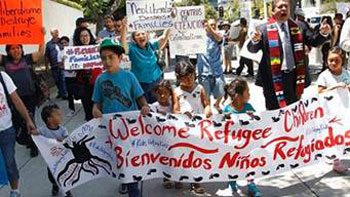 Two federal immigration court judges took a stand against President Obama’s decision to fast-track deportation hearings for the tens of thousands of unaccompanied children detained at the border then sent to detention camps. They are demanding that the immigration courts, currently under the Justice Department, be established as independent courts and sufficiently staffed for the difficult job they are required to do. As one judge has put it, they are being forced to deal with life and death issues in what amounts to a “traffic court” setting.
Two federal immigration court judges took a stand against President Obama’s decision to fast-track deportation hearings for the tens of thousands of unaccompanied children detained at the border then sent to detention camps. They are demanding that the immigration courts, currently under the Justice Department, be established as independent courts and sufficiently staffed for the difficult job they are required to do. As one judge has put it, they are being forced to deal with life and death issues in what amounts to a “traffic court” setting.
The two judges, leaders in the National Association of Immigration Judges, said the recent surge of immigrant children from Central America cast a spotlight on the problems of the nation’s immigration courts, spread out in more than 59 locations.
Dana Leigh Marks, union president and a San Francisco-based judge, said children need special protection and time to gain their trust because of their vulnerability. “The association has come out and said it is a mistake to bring these cases to the front of the docket,” Marks said in a televised news conference from Washington, D.C.
The judges face a situation where the administration has highly trained lawyers demanding deportation, while the children often have no lawyers or council of any kind. The judges are also often dealing with people completely inexperienced with U.S. courts and culture and language, yet the women and children are supposed to present a clear and very specific argument for asylum. Marks warned that children need more time, particularly when there is trauma involved. She also noted that judges face disciplinary action if they refuse to speed ahead. “A truly independent court needs separation from the executive branch’s enforcement prerogatives,” she said.
Denise Noonan Slavin, a union vice-president and a Miami-based judge, joined Marks in rejecting what have come to be known as “rocket dockets” for the speed with which people, many children, or mothers and their young children, are brought before the judges and that decisions are supposed to be taken. Slavin and Marks said the courts role should be as neutral arbitrators with a separation from the prosecutors. They said the administration’s lawyers exist in an “alternate legal universe” and, in an Alice in Wonderland literary reference, with challenges to requests for asylum that are “curiouser and curiouser.”
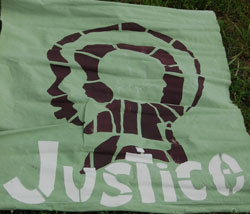 “There is no other court that would turn the docket on its head at the request of one party,” Slavin said. “But the immigration courts are flipping the docket by moving cases of newly arrived children to the front of the docket at the demand of the Department of Homeland Security.” She added, “…This is not an amusement park where you can fast-pass” proceedings, Slavin said. With the demand to fast-track the deportations, judges are being forced act counter to due process while also losing their discretion as judges in deciding the cases.
“There is no other court that would turn the docket on its head at the request of one party,” Slavin said. “But the immigration courts are flipping the docket by moving cases of newly arrived children to the front of the docket at the demand of the Department of Homeland Security.” She added, “…This is not an amusement park where you can fast-pass” proceedings, Slavin said. With the demand to fast-track the deportations, judges are being forced act counter to due process while also losing their discretion as judges in deciding the cases.
The judges said the courts were under-resourced, with a lack of staff, including judges. They said these difficulties raise basic questions such as whether notices to appear in court are sent to correct addresses or even received by the individual, with a failure to appear often meaning automatic deportation.
Many of the mothers with young children are forced to appear and tell their stories of rape and fear in front of their young children, while they are also attempting to care for them in court and trying to understand and respond to the questions being asked of them. The racism of the U.S. state is such that the culture shock the children and mothers contend with, lack of interpreters and legitimate fear of talking with police are dismissed as serious considerations in these cases.
The judges also brought out the use of force and increase in policing taking place, while the courts are not provided with the resources they require. The agency overseeing the courts — the Executive Office of Immigration Review — has a budget that is 1.7 percent of the $18 billion spent annually on immigration law enforcement.
In related news, two lawsuits have been filed against the U.S. government on due process grounds. One suit, filed in Seattle, challenges the government on the lack of government-paid attorneys for the children. Attorneys there are asking the suit be given class-action status.
The second suit, filed in Washington, D.C., accuses the U.S. government of running a “deportation mill” in its court system in Artesia, New Mexico, a newly opened detention center for families (see August Voice of Revolution for more). Hearings for hundreds of detained immigrant mothers with children have been held there. Detaining families like prisoners though they are guilty of no crime is itself against international law governing the rights of children. Now in addition the cases are being railroaded through with the few lawyers available sometimes not even permitted to visit their clients ahead of time or to speak in court.
The demands of the executive for fast-paced hearings and deportations has meant a wholesale attack on due process, backed up by disciplinary actions against judges that refuse to submit. Immigration issues may be the arena where this attack is now occurring, but there is little to say that it will not be extended more broadly.
[TOP]
Feds Planning Massive Family Detention Center
in South Texas
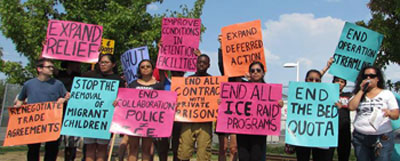 Federal officials are planning a new for-profit family detention lockup for immigrant children and their parents in South Texas. The 2,400-bed “South Texas Family Detention Center”— as Immigration and Customs Enforcement (ICE) is referring to it — is slated for a 50-acre site just outside the town of Dilley, 70 miles southwest of San Antonio.
Federal officials are planning a new for-profit family detention lockup for immigrant children and their parents in South Texas. The 2,400-bed “South Texas Family Detention Center”— as Immigration and Customs Enforcement (ICE) is referring to it — is slated for a 50-acre site just outside the town of Dilley, 70 miles southwest of San Antonio.
The detention center is part of the Obama administration’s response to the surge in children and families from Central America crossing the Texas-Mexico border. In a statement to the Observer, ICE spokeswoman Nina Pruneda said the facility was intended “to accommodate the influx of individuals arriving illegally on the Southwest border.”
The property is part of Sendero Ranch, a “workforce housing community,” better known in the oil patch as a “man camp” for oilfield workers. Sendero Ranch is owned by Koontz McCombs, a commercial real estate firm connected to San Antonio mogul Red McCombs. Loren Gulley, vice president for Koontz McCombs, said the company is still negotiating the deal but Corrections Corporation of America — the world’s largest for-private prison company — is expected to run the detention center, and Koontz McCombs would lease the existing “man camp” to ICE. A detailed site map provided to Frio County shows a large fenced campus, including both residential housing as well as a gym, chapel and “community pavilions.” The “man camp” has enough space to temporarily house 680 detainees while new structures are being built, ICE spokesman Bryan Cox said.
Frio County Commissioner Jose “Pepe” Flores said local officials had recently met with CCA and the landowner but no one from Immigration and Customs Enforcement.
The massive facility would double the existing federal capacity for immigrant families and is certain to anger immigrant advocates who say a for-profit lockup is inappropriate for families, especially young children. They point to the failed experiment with detaining immigrant families at T. Don Hutto Family Residential Center, a CCA-run facility about 45 minutes northeast of Austin. The Obama administration removed families from the former jail in 2009 after numerous allegations of human rights abuses, accounts of children suffering psychological trauma and a federal lawsuit filed by the ACLU and the University of Texas Law School Immigration Clinic.
“Given the shameful history of family detention at Hutto, it’s beyond troubling that ICE would turn back to Corrections Corporation of America to operate what would be by far the nation’s largest family detention center,” said Bob Libal, executive director of Grassroots Leadership, a nonprofit that opposes for-profit prisons. “While little kids and their families will suffer in this remote private prison, far away from legal or social services, this multi-billion-dollar private prison company stands to make enormous profits.”
Cox, the spokesman for ICE, would not confirm or deny CCA’s involvement, saying negotiations for the project were ongoing. “We’re in negotiations,” Cox said. “We haven’t signed a contract with anybody yet.” He said the number of beds and other details of the project could change.
Gulley, the Koontz McCombs vice president, said there was no time frame to close the deal but, he said, “if it does happen, it will happen fairly quickly.”
The Obama administration has pledged a ”truly civil” detention model for housing undocumented immigrants, though immigrant advocates have said progress has been halting at best. The influx of unaccompanied minors from Central America has sent private-prison company stocks soaring, while it has helped derail the administration’s commitment to reforming the Bush-era detention system.
Just in the past month, activists were in a fury because federal immigration officials refused to release from a Karnes County detention center a 7-year-old Salvadoran girl so she could get treatment for a life-threatening cancer. The girl and her mother had fled violence in El Salvador that the mother said prevented the girl from getting treatment. After mounting pressure, ICE finally relented and freed the girl and her mom. The Karnes facility was unveiled in 2012 as a model for a more humane approach to detention.
Over the summer, ICE converted a law enforcement training center in Artesia, New Mexico to a detention center housing immigrant families, many of whom are seeking asylum. Attorneys working at the remote facility told the Observer the conditions are poor and that the government is doing whatever it can to deport people as quickly as possible, returning some folks to the extreme violence and persecution they were fleeing
Libal said he was not impressed by the Obama administration’s promise to make the family facilities more like residential living centers than jails.
“The stories that are coming out [of Karnes] would show that…detaining families has the exact same effect it had at Hutto, the exact same disastrous impact on families.”
[TOP]
New Data on Unaccompanied Children in Immigration Court
Nine in Ten Children With No Lawyer Deported
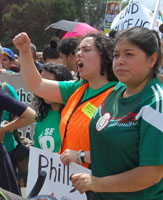 The recent surge of tens of thousands of unaccompanied children attempting to enter the country has touched off a heated debate. Some ask whether having Immigration Judges decide the fate of these children only postpones their inevitable deportation since it is alleged that few have any valid claim to remain in the United States. Others hotly dispute this contention.
The recent surge of tens of thousands of unaccompanied children attempting to enter the country has touched off a heated debate. Some ask whether having Immigration Judges decide the fate of these children only postpones their inevitable deportation since it is alleged that few have any valid claim to remain in the United States. Others hotly dispute this contention.
This special report presents information derived from current and detailed case-by-case Immigration Court records tracing decisions on removal orders sought by the Department of Homeland Security (DHS) concerning unaccompanied children who have been apprehended by the agency. The data, current through June 30, 2014, was obtained by the Transactional Records Access Clearinghouse (TRAC) at Syracuse University from the Executive Office for Immigration Review (EOIR) under the Freedom of Information Act.
The data trace the status of over 100,000 such cases. The information includes every instance over the last decade flagged as a juvenile case currently recorded in EOIR files. In each of these cases, the Department of Homeland Security instituted the action requesting that the court issue an order to deport these children. Because the DHS has authority to screen and then immediately deport unaccompanied Mexican children without any formal hearing, only a small proportion of children from Mexico are referred to the Immigration Court by the DHS. For this reason unaccompanied children who are immediately deported by DHS are not part of the court data examined here.
Cases filed in the courts in the last few years (since the increase began) make up about half of the total cases filed. As of end of June, court proceedings had been completed on 59 percent of all cases (60,209 matters out of the 101,850). Proceedings were ongoing for the remaining 41 percent. […]
While public attention has been focused on the plight of juveniles arriving at our borders and their growing numbers, unaccompanied children make up a small proportion of those impacted by the current administration's enforcement activities. Although the recorded number of new Immigration Court juvenile cases during the last three months (April - June 2014) has doubled over the previous six months of this fiscal year (October 2013 - March 2014), these cases still make up only 11 percent of the Immigration Court's backlog — a total of 41,641 pending juvenile cases out of the total backlog of 375,503 cases.
How Often Does a Child Appear Unrepresented?
It is well established that the odds of prevailing in court are much better for an individual who has the assistance of a lawyer. Yet the government is under no obligation to provide legal counsel to the indigent — even if they are children — in Immigration Court proceedings. Meanwhile, the government itself is always represented by an attorney.
Few children appearing in Immigration Court have the financial resources to hire an attorney, even though in most of the matters it is reasonable to assume they do not comprehend the nature of the proceedings they face or the complex procedural and substantive challenges of the immigration law. (Of course, there is also a language barrier, since most unaccompanied minors do not speak English.) While many immigration lawyers and law clinics attempt to provide legal assistance on a pro bono basis, their numbers are insufficient to meet the need. One result of this is that children were not represented about half of the time (48%) they appeared in Immigration Court, although there is wide variation by state and hearing location. Less than a third (31%) have thus far been able to secure an attorney in currently pending cases.
How Often Do Immigration Judges Conclude That Children Can Stay?
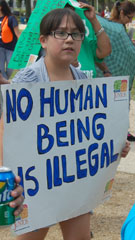 The data show that in a large number of cases, Immigration Judges decline to order these children's removal. Many are found to have legitimate legal grounds to remain in this country. The data also show that outcomes in these cases are all too often determined by whether an attorney was present to assist the child in presenting his or her case. For this reason, results are tabulated separately for children with and without representation. (For those cases in which Immigration Court proceedings have concluded, the child was represented in 31,036 cases, and appeared without an attorney in the remaining 29,173 of juvenile cases heard by an Immigration Judge.)
The data show that in a large number of cases, Immigration Judges decline to order these children's removal. Many are found to have legitimate legal grounds to remain in this country. The data also show that outcomes in these cases are all too often determined by whether an attorney was present to assist the child in presenting his or her case. For this reason, results are tabulated separately for children with and without representation. (For those cases in which Immigration Court proceedings have concluded, the child was represented in 31,036 cases, and appeared without an attorney in the remaining 29,173 of juvenile cases heard by an Immigration Judge.)
Here are the results in brief:
Outcome if attorney present. In almost half (47%) of the cases in which the child was represented, the court allowed the child to remain in the United States. The child was ordered removed in slightly more than one in four (28%) of these cases. And in the remaining quarter (26%) the judge entered a "voluntary departure" (VD) order. (While with a VD order the child is required to leave the country, the child avoids many of the more severe legal consequences of a removal order.)
Outcome if no attorney. Where the child appeared alone without representation, nine out of ten children were ordered deported — 77 percent through the entry of a removal order, and 13 percent with a VD order. One in ten (10%) were allowed to remain in the country. […]
Given the increasing numbers of unaccompanied children that are now arriving, it is reasonable to ask the question "Do these children appear to have any less legitimate claims to remain in the country than those who arrived earlier in the decade?" Answers to this question must be tentative, given the large proportion of cases that remain to be decided for children who have arrived recently. However, outcomes thus far do not suggest that children who have arrived during the recent surge present less worthy cases. Examining cases filed during the last 21 months (FY 2013 through June 30, 2014) for which outcomes have been reached, a greater proportion of the children have been allowed to remain in this country, and a smaller percentage were ordered deported, relative to earlier cohorts of children. This was true both for those who were represented as well as those who were not. For example, for children who had the assistance of an attorney, less than one out of three were ordered deported, while two-thirds were allowed by the Immigration Judge to stay. This is a higher proportion of children allowed to remain in the U.S. than the roughly 50/50 split that was previously seen for the decade as a whole. Even without the assistance of an attorney, over a quarter of recently arrived children have been allowed by an Immigration Judge to remain, as compared with only 10 percent for the decade as a whole. […]
DHS itself can recommend that a case be closed and the child be allowed to remain in the country through the exercise of its longstanding prosecutorial discretion (PD) authority. Since FY 2012, the court has included PD as a basis for the closure of a case. Since that time, PD has been the reason for 9 percent of juvenile closures. Examined another way, this amounts to 3 percent of all concluded juvenile cases filed during the last decade.
Immigration Backlog Years Long
The number of cases awaiting resolution in the Immigration Courts grew to 396,552 by the end of July 2014. This backlog increased by nearly 75,000 cases, or 22 percent, since the start of fiscal year 2013, according to very timely government enforcement data obtained by TRAC.
The California Immigration Courts continued to have the greatest backlog with 81,022 cases. Second was Texas, where the backlog of 69,625 cases rose 74 percent since the start of FY 2013. The third largest backlog was in New York, where 57,204 cases were awaiting resolution.
The longest waiting times were found at the Imperial, California hearing location, where a backlog of 1,208 cases were waiting an average of 857 days to be resolved as of July 31. The next highest wait times were found at the Omaha, Nebraska hearing location, where 4,992 cases have been waiting an average of 840 days. The average wait time for the 77 juvenile cases at Omaha was only 10 days, however.
The 10,984 cases at the Phoenix, Arizona hearing location had the third longest waiting time, an average of 805 days as of July 31. The 200 juvenile cases there had an average waiting time of only 66 days.
Note that not all court locations have separately reported waiting times for juvenile cases. TRAC has requested more comprehensive court data on scheduling and waiting times for juvenile cases, and will report these details once the additional information is received.
[TOP]
Children in Danger: A Guide to the Humanitarian Challenge at the Border
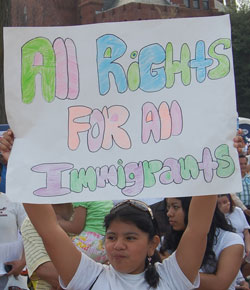 The American Immigration Council has prepared this guide in order to provide policymakers, the media, and the public with basic information surrounding the current humanitarian challenge the U.S. is facing as thousands of young migrants show up at our southern border. This guide seeks to explain the basics…The children’s reasons for coming to the United States, their care, our obligations to them as a nation, and the implications for foreign and domestic policies are critical pieces we must understand as we move toward solutions. […]
The American Immigration Council has prepared this guide in order to provide policymakers, the media, and the public with basic information surrounding the current humanitarian challenge the U.S. is facing as thousands of young migrants show up at our southern border. This guide seeks to explain the basics…The children’s reasons for coming to the United States, their care, our obligations to them as a nation, and the implications for foreign and domestic policies are critical pieces we must understand as we move toward solutions. […]
Who are the unaccompanied children?
The vast majority of unaccompanied children come from Mexico, Guatemala, Honduras, and El Salvador, although unaccompanied children may arrive from any country. The recent increase in arrivals is due to the migration of children from Guatemala, Honduras, and El Salvador — a region of Central America known as the “Northern Triangle.” According to U.S. Customs and Border Protection (CBP), 57,525 unaccompanied children were apprehended at the southwest border between October 1, 2013, and June 30, 2014. The largest number of children (29 percent of the total) came from Honduras, followed by Guatemala (24 percent), Mexico (23 percent), and El Salvador (22 percent).
Why are these Children and Families Leaving Their Home Countries?
Researchers consistently cite increased Northern Triangle violence as the primary recent motivation for migration, while identifying multiple causes including poverty and family reunification. A report by the Assessment Capacities Project (ACAPS), citing 2012 United Nations Office on Drugs and Crime (UNODC) data, highlighted that Honduras had a homicide rate of 90.4 per 100,000 people. El Salvador and Guatemala had homicide rates of 41.2 and 39.9, respectively. In comparison, the war-torn country of the Democratic Republic of the Congo, from which nearly half a million refugees have fled, has a homicide rate of 28.3 per 100,000 people. Furthermore, in a recent report Tom Wong took the UNDOC data and compared it to the data on unaccompanied children provided by CBP. Wong found a positive relationship between violence and the flow of children: “meaning that higher rates of homicide in countries such as Honduras, El Salvador, and Guatemala are related to greater numbers of children fleeing to the United States.”
While there can be multiple reasons that a child leaves his or her country, children from the Northern Triangle consistently cite gang or cartel violence as a prime motivation for migrating. Research conducted in El Salvador on child migrants who were returned from Mexico found that 61 percent listed crime, gang threats, and insecurity as a reason for leaving. The report, Children on the Run, by the United Nation’s High Commission for Refugees (UNHCR) found that 48 percent of the 404 children UNHCR interviewed “shared experiences of how they had been personally affected by the…violence in the region by organized armed criminal actors, including drug cartels and gangs or by State actors.” Furthermore, the youth are frequently the target of the violence. Recruitment for the gangs begins in adolescence—or younger—and there are incidents of youth being beaten by police who suspected them of gang membership. […]
Research conducted by Elizabeth Kennedy, a Fulbright scholar in El Salvador, indicates that violence is the primary cause, even among those who also cite poverty or family reunification as reasons for their departure. This influx is not limited to the United States, as growing numbers of adults and children from those countries are also seeking refuge in Mexico, Panama, Nicaragua, Costa Rica, and Belize. Conditions in El Salvador, Honduras, and Guatemala have reached a tipping point, and more people are reaching the conclusion that they can no longer stay safely in their homes.
Would More Border Patrol Resources Deter Border Crossers?
There is little evidence to support the proposition that the border must be further fortified to deter an influx of children and families. The flow of undocumented immigrants into the United States is tied more to economic factors than to increased enforcement. In this case, fear of violence is motivating the influx. In addition, Custom and Border Protection (CBP)’s resources along the southwest border are already significant. There were 18,611 Border Patrol agents stationed along the southwest border as of Fiscal Year (FY) 2013. The annual Border Patrol budget now stands at $3.5 billion. The Border Patrol has at its command a wide array of surveillance technologies: ground radar, cameras, motion detectors, thermal imaging sensors, stadium lighting, helicopters, and unmanned aerial vehicles. Treating the current situation as simply another wave of illegal immigration misses the broader policy and humanitarian concerns that are driving it. In fact, many children are turning themselves over to Border Patrol agents upon arrival and are not seeking to evade apprehension.
International protection obligations
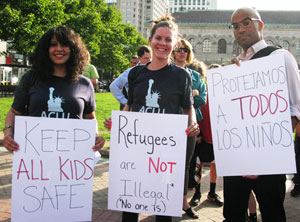 The United States has entered into numerous treaties with other countries to ensure the protection and safe passage of refugees. Among the most important are the 1952 United Nations Convention Relating to the Status of Refugees and the 1967 Protocol. Under these treaties, the United States may not return an individual to a country where he or she faces persecution from a government or a group the government is unable or unwilling to control based on race, religion, nationality, political opinion, or membership in a particular social group. A separate treaty, known as the Convention Against Torture, prohibits the return of people to a country where there are substantial grounds to believe they may be tortured.
The United States has entered into numerous treaties with other countries to ensure the protection and safe passage of refugees. Among the most important are the 1952 United Nations Convention Relating to the Status of Refugees and the 1967 Protocol. Under these treaties, the United States may not return an individual to a country where he or she faces persecution from a government or a group the government is unable or unwilling to control based on race, religion, nationality, political opinion, or membership in a particular social group. A separate treaty, known as the Convention Against Torture, prohibits the return of people to a country where there are substantial grounds to believe they may be tortured.
The United States has implemented these treaties in various laws and regulations. They form the basis for both our refugee program and asylum program. (An asylee is simply a refugee whose case is determined in the United States, rather than outside it.) In fact, under our laws, anyone in the United States may seek asylum with limited exceptions, or protection from torture with no exceptions. It can be difficult, and often complicated, to determine whether an individual has a valid claim for asylum or protection from torture. For children, ensuring that they are safe, have an understanding of their situation and their rights, and have adequate representation when they tell their story to a judge are all important components of ensuring that the U.S. meets its protection obligations.
Do Central American Children Qualify for International Protection?
Many of the children fleeing to the United States have international protection needs and could be eligible for humanitarian relief. According to UNHCR’s survey of 404 unaccompanied children from Mexico, El Salvador, Honduras, and Guatemala, 58 percent “were forcibly displaced because they suffered or faced harms that indicated a potential or actual need for international protection.” Notably, of those surveyed, UNHCR thought 72 percent of the children from El Salvador, 57 percent from Honduras and 38 percent from Guatemala merited protection. While international protection standards are in some cases broader than current U.S. laws, the fact that over 50 percent of the children UNHCR surveyed might qualify as refugees suggests that a thorough and fair review of these children’s claims is necessary to prevent them from being returned to danger.
Moreover, children may also qualify for particular U.S. forms of humanitarian relief, based on laws that recognize children as victims of trafficking and crime, or as children who have been abused or abandoned by their parents. A 2010 survey conducted by the Vera Institute of Justice indicated that 40 percent of children screened while in Office of Refugee Resettlement (ORR) custody could be eligible for relief from removal under U.S. laws. Given their age, the complexity of their claims, and the trauma that generally accompanies their journey, determining whether these children qualify for some form of protection can be a time-consuming process — one that is not easily completed in a short period of time. […]
Procedures and Policies
How are unaccompanied children treated compared to adults and children arriving in families?
Adults, families, and unaccompanied children are treated differently under U.S. law.
Adults, when apprehended, are traditionally placed in removal proceedings before an immigration court. However, in FY 2012, 75 percent of adults removed by the U.S. were removed through summary, out-of-court removal proceedings by a DHS officer rather than appearing before an immigration judge. This commonly occurs through expedited removal, when an adult noncitizen encounters immigration authorities at or within 100 miles of a U.S. border with insufficient or fraudulent documents. This also commonly occurs through “reinstatement of removal,” when an adult noncitizen unlawfully reenters after a prior removal order. Most adults apprehended at or near the border will be placed into expedited removal or reinstatement of removal.
Families (adults traveling with children) can also be processed under these provisions. Unaccompanied children, however, receive greater protections under U.S. law.
The majority of unaccompanied children encountered at the border are apprehended, processed, and initially detained by CBP, which is a part of the Department of Homeland Security (DHS). Unlike adults or families, though, unaccompanied children cannot be placed into expedited removal proceedings under the Trafficking Victims Protection Act, signed into law in 2000 to address human trafficking concerns. It was subsequently reauthorized during both the Bush and Obama administrations in 2003, 2005, 2008, and 2013, and subsequently referred to as the TVPRA. The TVPRA requires that all unaccompanied alien children be screened as potential victims of human trafficking.
The TVPRA of 2008 responded to concerns that unaccompanied children apprehended by the Border Patrol “were not being adequately screened” for eligibility for protection or relief in the United States. The TVPRA also directed the development of procedures to ensure that if unaccompanied children are deported, they are safely repatriated.
Children from non-contiguous countries, such as El Salvador, Guatemala, or Honduras, are placed into standard removal proceedings in immigration court. CBP must transfer custody of these children to Health and Human Services (HHS) within 72 hours. […]
Can Unaccompanied Children be Detained?
Yes, but special laws govern the custody of children based on child welfare standards that take the “best interests” of the child into account. As background, adults who are processed by CBP (if encountered at or near the border) are held in short-term CBP custody and then transferred to Immigration and Customs Enforcement (ICE) custody. As a DHS report found, despite the civil nature of immigration laws, “the facilities that ICE uses to detain [adults] were built, and operate, as [criminal] jails and prisons,” with “only a few exceptions.”
Children who arrive with a parent may be detained by DHS in family detention centers.
Unaccompanied children must be transferred by DHS to the custody of HHS within 72 hours of apprehension, under the Homeland Security Act of 2002 and TVPRA of 2008. The HHS’s Office of Refugee Resettlement (ORR)’s Unaccompanied Alien Children Program then manages custody and care of the children until they can be released to family members or other individuals or organizations while their court proceedings go forward.
Under the TVPRA of 2008, HHS is required to “promptly place” each child in its custody “in the least restrictive setting that is in the best interests of the child.” As such, children in a part of the Department of Health and Human Services, ORR care are generally housed through a network of state-licensed, ORR-funded care providers, who are tasked with providing educational, health, and case management services to the children.
Under international law, children “should in principle not be detained at all,” according to UNHCR. Detention, if used, should only be a “measure of last resort” for the “shortest appropriate period of time,” with an overall “ethic of care.” Detention has “well-documented” negative effects on children’s mental and physical development, including severe harm such as anxiety, depression, or long-term cognitive damage, especially when it is indefinite in nature.
Can Unaccompanied Children be Released from Custody?
Yes. ORR seeks to reunify children with family members or release them to other individual or organizational sponsors whenever possible, on the grounds that children’s best interests are served by living in a family setting.
As of May 2014, ORR reported that the average length of stay in its facilities was approximately 35 days and that about 85 percent of the children served are released while their deportation proceedings are in progress. […]
ORR is also required to ensure that individuals taking custody of the children are able to provide for their well-being. A court settlement in the case Flores v. Reno outlines the following preferences for sponsors: (1) a parent; (2) a legal guardian; (3) an adult relative; (4) an adult individual or entity designated by the child’s parent or legal guardian; (5) a licensed program willing to accept legal custody; or (6) an adult or entity approved by ORR. The sponsor must agree to ensure that the child attends immigration court.
Why is the Government Opening Family Detention Facilities?
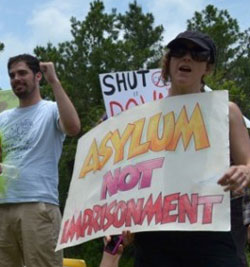 The increase in families arriving at the southwest border — frequently mothers with children — has re-ignited a debate over the appropriate treatment of families in the immigration system. Family immigration detention has a complicated and troubled history in the U.S.
The increase in families arriving at the southwest border — frequently mothers with children — has re-ignited a debate over the appropriate treatment of families in the immigration system. Family immigration detention has a complicated and troubled history in the U.S.
Prior to 2006, ICE commonly detained parents and children separately. In FY 2006 appropriations language, however, Congress directed ICE to either “release families,” use “alternatives to detention such as the Intensive Supervised Appearance Program,” or, if necessary, use “appropriate” detention space to house families together.
ICE responded by opening the T. Don Hutto Residential Center in Texas, with over 500 beds for families. The Women’s Refugee Commission, however, explained that it was a “former criminal facility that still looks and feels like a prison.” For example, although DHS claimed Hutto was specially equipped to meet the needs of families, reports emerged that children as young as 8 months old wore prison uniforms, lived in locked prison cells with open-air toilets, were subject to highly restricted movement, and were threatened with alarming disciplinary tactics, including threats of separation from their parents if they cried too much or played too loudly. Medical treatment was inadequate and children as young as 1 year old lost weight.
The Hutto detention center became the subject of a lawsuit, a human rights investigation, multiple national and international media reports, and a national campaign to end family detention. In 2009, ICE ended the use of family detention at Hutto, withdrew plans for three new family detention centers, and said that detention would be used more “thoughtfully and humanely.” The recent announcement that ICE will open additional family detention centers, with the first facility in Artesia, New Mexico, marks the first expansion of family detention since Hutto’s closing. (see August VOR for a report on horrendous conditions at Artesia).
Family detention is rarely in the “best interests of the child,” as opposed to community-based alternatives. Families and children require specialized educational, medical, and legal support. But although governments can control families in detention, critics have argued that detaining families in jail-like settings profoundly impacts the emotional and physical well-being of children and breaks down family relationships. Parents reported that guards frequently threatened children with separation from parents for misbehavior, with children losing respect for parents because of parents’ lack of control. Additionally, parents reported being forced to meet lawyers and discuss details of abuse in front of their children. Conversely, countries like Belgium have open reception facilities for migrant families seeking asylum, where they can come and go at will with certain restrictions. Caseworkers are assigned, and officials report high rates of attending proceedings.
Can Alternatives to Detention Be Used?
Yes. ICE operates alternatives to detention (ATD) for adult detainees — one program with case management, supervision, and electronic monitoring, and another program with electronic monitoring only. U.S. government data shows that alternatives to detention are 96 percent effective in ensuring appearance in immigration court. Alternatives, as well as being more humane, are also less expensive than detention—$17/day and less, as opposed to $159/day. Bipartisan support has emerged for alternatives to immigration detention, as it has emerged for alternatives to criminal incarceration.
There appears to be no legal barrier to using alternatives to detention for families who would otherwise be in family detention. It is unclear whether supervision techniques such as electronic tracking bracelets will be used on children.
[TOP]
